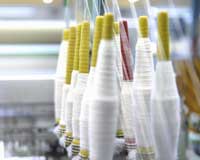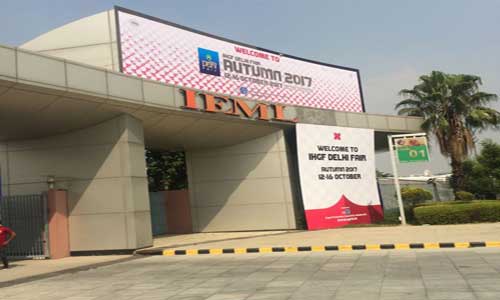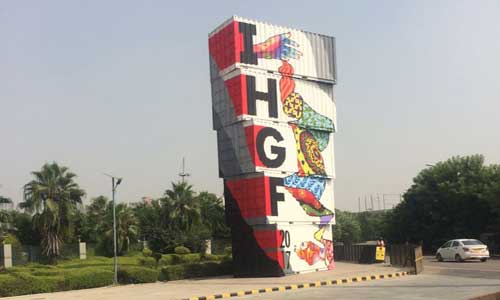FW
Some of the world’s most renowned clothing and textile companies, including Burberry, Adidas, Kathmandu and Timberland, have pledged to use 100 per cent sustainable cotton by 2025. Timberland, for instance, is moving beyond just minimizing environmental impacts to strategically creating real environmental and social benefits within the supply chain.
Substantial gains have been made over the past few years in scaling the production of sustainable forms of cotton, which is now higher than ever at more than three million tons in 2016. However companies are actively sourcing less than a fifth of this available sustainable cotton.
The companies that have pledged their support are at various stages on their journey to using sustainable cotton, with some already securing all of their cotton from sustainable sources. However, all are clear that collaboration across the sector is needed to bring about transformative change.
In all 36 major brands and retailers have now signed up to the 100 per cent by 2025 pledge, including four of Forbes magazine’s list of the world’s ten largest global apparel brands and three of the top ten UK clothing retailers.
Commitment made by companies will help drive sustainable practices across the sector. In turn, this will help alleviate the environmental and social costs that are associated with cotton production, including the over-use of pesticides, the release of greenhouse gases, the depletion of local water sources and rising costs of production.
Bemis has unveiled Sewfree Elevation, a new adhesive for heat-sensitive fabrics. Formulated specifically for heat-sensitive fabrics, this product provides best-in-class stretch and recovery, without compromising the hand feel of luxury fabrics such as lace. In addition to a better fit and wearing experience, Sewfree Elevation allows factories to assemble garments up to 52 per cent faster.
Intimates in China have moved from basic apparel to highly-regarded fashion staples, and new local brands are prompting Chinese women to rethink the meaning of comfort related to intimates. Bemis wants to help Chinese designers and innovators in this space to maximize their potential by using the most effective, high-quality technology in their apparel, while avoiding counterfeit bonding products falsely positioning themselves as Sewfree.
For more than 107 years, Bemis has developed the best in Sewfree products and technology. Its research in the Chinese market led it to two specific areas of improvement when it comes to the design of bras and underwear – fit and breathability. The new collection shows designers how to build a better bra from a technical standpoint and how to layer in inspiration from the runway.
Bemis has also collaborated with Hong Kong-based intimates manufacturer Clover to produce a collection of bonded bras, panties, and men’s boxers.
India is progressively eating into Bangladesh’s share in the global apparel trade. For instance, India last year was the third biggest exporter of garment items to the US, which happens to be Bangladesh's single largest export destination. In the first eight months of this year, India climbed up to the second spot, while Bangladesh slipped from the fourth position to the sixth.
Thanks to the stimulus package, Indian manufacturers can offer lower prices and are fast catching up with their Bangladesh counterparts. In 2016, India's share in the global apparel trade was four per cent and Bangladesh’s 6.4 per cent. Moreover, the Indian rupee has devalued a lot against the dollar. India’s apparel exports last fiscal year were up 15 per cent year-on-year.
In contrast, Bangladesh, despite even being the second largest garment exporter after China, shipped items that were an increase of just 0.20 per cent from a year earlier. India’s garment shipments are expected to grow between 15 per cent and 18 per cent this fiscal year.
The US market, which accounts for 30 per cent of India’s apparel exports, is doing reasonably well. South America, Europe, Middle East and Japan are other promising markets for India.
"Till recently, China used to dominate the global market of textiles and apparel, footwear and furniture but rising wages have disrupted its global competitiveness in labour-intensive sectors. Now China is readying itself to venture into hi-end skilled manufacturing verticals. As per figures, in 2010, low-value apparel and home textiles accounted for 51 per cent and 29 per cent of China’s textile industry respectively. But in 2014, their share came down to 46.8 per cent and 28.6 per cent, with the share of value-added industrial textiles rising from 20 per cent to 24 per cent. This share is further projected to decline by 2025."

Till recently, China used to dominate the global market of textiles and apparel, footwear and furniture but rising wages have disrupted its global competitiveness in labour-intensive sectors. Now China is readying itself to venture into hi-end skilled manufacturing verticals. As per figures, in 2010, low-value apparel and home textiles accounted for 51 per cent and 29 per cent of China’s textile industry respectively. But in 2014, their share came down to 46.8 per cent and 28.6 per cent, with the share of value-added industrial textiles rising from 20 per cent to 24 per cent. This share is further projected to decline by 2025. This would create a $50 billion opportunity for other low-cost producers in apparel market alone, according to FASH455, a global apparel and textile trade and sourcing agency.
Where does India stand?

With over 40 per cent contribution towards exports, Indian textile industry has been shining high. With China vacating space, the country hopes to take the larger share of the pie. But close rivals like Bangladesh, Vietnam and Cambodia, are giving it a tough fight. In this scenario, India needs to project its inherent competitiveness to expand export potential. In 2000, India held 3 per cent share of apparel export market while Bangladesh’s and Vietnam’s shares stood at 2.6 per cent and 0.9 per cent respectively. But in 2016, with Bangladesh and Vietnam seeing their market shares jump to 6.4 per cent and 5.5 per cent respectively, zooming past India whose share modestly increased to 4 per cent. Meanwhile, Ethiopia too is emerging as a serious player in the global apparel market. The African country exported textile and apparel worth $7.32 billion in 2015, which it has targeted to raise to $30 billion by 2025. Apparels also stand to be the highest employment generator for the country. For every Rs1 lakh investment, nearly 24 jobs are created, compared to 1.3, 0.3 and 0.1 in food processing, auto and steel respectively. Moreover, it has the highest potential to absorb women workers.
Footwear and furniture
India is scoring low in footwear and furniture export markets too. Country’s footwear exports, valued at $2.54 billion in 2013, came down to $0.42 billion in 2016. In comparison, Vietnam exported footwear worth $18 billion during the same year, next only to China. India’s export of furniture bedding and mattress shrunk to $0.2 billion in 2016 from $1.09 billion in 2013. While China sustaining the lead, developing countries like Poland, Mexico and Vietnam have also emerged as significant contributors.
According to credit rating agency Fitch, Bangladesh and Vietnam already have strong footholds in these sectors. Together they accounted for 8 per cent of global clothing, footwear and furniture exports in 2015, up from 3 per cent in 2010. This established scale could be an advantage. Bangladesh, for example, has a ready-made garments industry that accounts for over 80 per cent of its exports, and has the capacity to meet large orders swiftly.
How can India stand to gain?
As per UN Comtrade, a significant drop in China’s low-end manufacturing over the coming decades would leave a large gap for lower-cost countries to exploit. China’s global share of exports of clothing, footwear and furniture is still almost 40 per cent. However, the decline now appears to be gathering momentum – China’s exports of these labour-intensive goods fell by 10 per cent in dollar terms in 2016. A 2014 Boston Consulting Group report suggests, the cost of Indian labour has remained virtually flat over the past decade when adjusted for productivity gains. By contrast, labour costs in China’s coastal provinces have nearly tripled.
Bangladesh's apparel exports to China and Japan world's second-and third-largest economies fell significantly this fiscal as businesses failed to reap benefit of duty-free market access. Exporters cited a number of bottlenecks that caused the fall.
The country received $74.30 million from apparel exports to China in a 10.15 per cent negative growth during the period over that of corresponding period of FY2016-17, according to data available with the Export Promotion Bureau. Growth in export earnings from Japan also declined, by 9.81 per cent to $170.83 million, during the July-September period of the current fiscal from $189 million fetched in the corresponding period of last fiscal.
Exporters and experts found the absence of proper networking from the industry level to increase the bilateral trade with China and Japan, resulting in the setback. Former president of Bangladesh Knitwear Manufacturers and Exporters Association (BKMEA) Fazlul Haque held the private entrepreneurs responsible for the poor performance on the vast Chinese market. According to him Vietnamese exporters get advantage due to their proximity with China and also because they make diversified products using manmade fibres. On the other hand, apparel exports to major traditional markets witnessed a mixed growth, data showed.
Germany, the single-largest EU destination for Bangladesh apparel items, imported garments worth $1.29 billion in July-September period, a meagre growth of 0.85 per cent over the corresponding figure in 2016-17.The country's earnings from France recorded a slow growth of 4.85 per cent to $374.11 million.
Argentina’s wool industry will adopt the language, content and best practices of Responsible Wool Standard (RWS). This means that from 2018, the Argentinian wool sector will use RWS as a basis for the outreach and training of the country’s sheep farmers.
RWS is meant to facilitate the adoption of improved sustainability practices in Argentina’s wool textile sector. It aims at providing the industry with a tool to recognise the best practices of farmers, ensuring that wool comes from farms with a progressive approach to managing their land, and from sheep that have been treated responsibly. The practice of mulesing to suppress fly-strike is not allowed. Brands such as H&M, Coyuchi, Patagonia, Eddie Bauer, Kathmandu, Marks & Spencer and Tchibo among others are involved in the RWS program.
Argentina is one of the five major wool producing and exporting countries in the world. The major sheep-producing area in Argentina is the Patagonia region in the south where there are around 10.5 million sheep, of which 75 per cent are Merino.
Argentine wool growers have benefited from improvement in world wool prices and from a massive devaluation of its currency at the end of 2001, which gave a considerable boost to its export industries, including wool.
AEPC hopes the embedded taxes arising out of the inverted structure will be refunded to exporters through appropriate mechanisms. The duty structure remains inverted with fabric at five per cent GST. AEPC says the key issue of embedded taxes needs to be taken up to address the genuine concerns of exporters and export sentiments. Invisible taxes need to be considered for refund under drawback and Remission of State Levies (RoSL) schemes, so that the calibrated refund provided is representative of the tax incidences incurred by the industry.
In the absence of encouraging duty drawback and RoSL exports from the sector will further witness a sharp decline just ahead of the peak festival season. The appreciating rupee and new levies like GST on intra-company stock transfers, job work, freight and samples have led to cost escalation for exporters further narrowing their low margins in competitive global markets.
There has been a reduction in the rate of GST on man-made items including synthetic filament yarn such as nylon, polyester and acrylic, and artificial filament yarn, yarn of manmade staple fibers, real zari from 18 per cent to 12 per cent. There is a provision for refund of GST for the month of July by October 10 and for August by October 18, which will ease the working capital stress. A facility of e-wallet has also been introduced for addressing the refund issue.

The fair which has been playing a vital role in providing a platform to Indian exhibitors of home, lifestyle, fashion and textiles products for the last 23 years is back this year starting form today. The Indian Handicrafts and Gifts Fair (IHGF) at India Expo Centre and Mart, Greater Noida will showcase the abundance of raw materials products backed by a rich heritage of design and handcrafting skills until October 16.
IHGF is amongst Asia's largest gifts and handicrafts fair, held biannually (spring and autumn edition) and organised by Export Promotion Council for Handicrafts (EPCH). Union Minister of Textiles, Ministry of Textiles, Smriti Zubin Irani will be inaugurating the fair. The five power-packed days with over 2750 exhibitors, spread over 190,000 sq metres area, brings you an entire range of home, lifestyle, and fashion accessories, with a traditional artistic finish in perfect harmony with modern designs and contemporary colours.

Visitors can go through materials like housewares, gifts, decorative, furniture, garden and outdoor, bathroom accessories, home furnishing, carpets, rugs, floor accessories, lamps and lighting, Christmas and holiday decor, spa and wellness, handmade paper items, educational games, trophies, fashion jewellery and accessories, stationery and gifts at this unique fair.
"The Limca book of world's records has already recognised the IHGF-Delhi Fair as the world's largest congregation of handicrafts exhibitors under one roof," informed Rakesh Kumar, Executive Director, Export Promotion Council for Handicrafts (EPCH).
The people who will be visiting the show includes buyers from across the globe who are wholesalers, distributors, chain stores, departmental stores, retailers, mail order companies, brand owners, buying houses and designers and forecasters. The show will also have visitors from major Indian Retail and online brands like Fab India, Westside, Trends, The Wishing Chair, Furniture Walla, Goodearth and many more.
The overseas buyers from over 100 countries include Argentina, Austria, Belgium, Brazil, Canada, Chile, China, Denmark, France, Germany, Greece, Holland, Hong Kong, Italy, Israel, Japan, Korea, Mexico, New Zealand, Norway, Oman, Philippines, Poland, Qatar, Romania, Russia, South Africa, Slovakia, Spain, Sweden, Switzerland, Thailand, Turkey, USA, UAE, UK and Zimbabwe.

Major departmental stores who have already confirmed their visit to the show include Roost, Kirkland's, Pier1 Imports, Two's Company Inc., Interlude Home Inc. BBB, Anthropologie, Design House, Century Sourcing, Prestige Cutlery, Accent Décor, Apropos International, Kalalou, Appleman & Schauben, Interior Home Inc. and Hoesh International from USA, The Libra Company, UK, LDR Furniture group, Heine, Atlas Einrichtungs, Lambert from Germany, Eurogroup from Hong Kong, Lifestyle and Redtag from UAE, The Moshi from Sweden, Manor AG and Migros from Switzerland, Rivera Maison from Netherlands, & Samsara Furniture from Australia, Aux Fil De Saison from France and Ningbo D. Sky Home from China.
Based on a survey conducted during previous editions of the show, buyers from across the globe prefer to visit the IHGF-Delhi fair due to a great product range, attractive prices, different varieties, distinct quality and new product lines.
The extravaganza will also witness a live demonstration, regional craft, and knowledge seminars with complimentary facilities.
During this edition, a pavilion of cane and bamboo products from North-Eastern region and Jodhpur cluster will also be set up. Knowledge seminars will be on different and important subjects such as investments in handicrafts sector, goods and services tax, necessary compliances for handicrafts sector, neuroscience in marketing, survey from Telangana and trends and forecast 2019.
OP Prahladka, Chairman, EPCH elaborated that the quest for seeking something different, unusual and new drives a large number of buyers from all over the world to visit IHGF-Delhi fair during each edition and during this edition too buyers visit will be more than the previous years.

CAITME was held in Uzbekistan from September 13 to 15, 2017. This is an exhibition of textile machinery and was attended by 353 companies from 22 countries including Austria, Germany, India, Spain, Italy, China, South Korea, and Japan. From China there were 65 participating companies, from Turkey 56 and from Germany 36. These were the most active participants at the exhibition this year.
The exhibition saw a growth up to 35 per cent as compared to the previous year. The whole range of equipment and technologies for the textile and light industry starting from yarn production to packaging of readymade garments and knitwear was showcased at the exhibition. Many companies had arranged live demonstrations of machines and equipment and delivered master classes at their stands.
The sewing and embroidery equipment sector was one of the most popular among participants and professional visitors. Twenty companies from all over the world presented products which contribute to employment for a great number of unemployed women and strengthen the potential of small business.
Held alongside CAITME was Textile Expo. This presented textiles, semi-finished products and ready garments and apparel of leading companies from Uzbekistan, China, Turkey, Belarus and Russia. Uzbekistan’s textile and light industry is favoured through availability of raw materials, including cotton fiber and silk, an amicable environment for doing business, a package of benefits and privileges for investors and overall political and macroeconomic stability of the country.
Tintex, based in Portugal, is a maker of naturally advanced, smart and responsibly crafted jersey fabrics which are used in the fashion, sports and lingerie markets. Its mission is to amplify and grow an eco-sustainable strategy for all its production, investment and fabric innovations and spread this message of change, best practice and influence throughout the contemporary textile fashion system.
One of its customers is Filippa K, a leading Nordic fashion brand dedicated to a carefully curated contemporary consumer wardrobe. Emblematic pieces are the flowy jersey dress spice, a wide strap dress with high side slits and a flowy A-line shape, and the flowy maxi skirt spice with a high front slit and a drapey feel. Both are made from sustainable lyocell by Tintex.
Another customer is Ekyog, a French fashion brand. The brand has 32 stores in France. Ekyog chose a 3D interlock jacquard 100 per cent recycled polyester by Tintex for a boxy teddy with a teddy collar closed by metal snaps. Tintex materials have also been included in the line Merry from the Bohemian Rhapsody history collection. This is an interlock jacquard with 86 per cent recycled polyester. The material is chosen for a mid-length jacket in jacquard 3D knit with loose volume, armhole down and closed by metal snaps.












